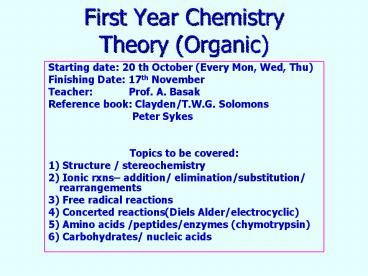First Year Chemistry Theory (Organic) PowerPoint PPT Presentation
1 / 12
Title: First Year Chemistry Theory (Organic)
1
First Year ChemistryTheory (Organic)
- Starting date 20 th October (Every Mon, Wed,
Thu) - Finishing Date 17th November
- Teacher Prof. A. Basak
- Reference book Clayden/T.W.G. Solomons
- Peter Sykes
- Topics to be covered
- 1) Structure / stereochemistry
- 2) Ionic rxns addition/ elimination/substitution/
rearrangements - 3) Free radical reactions
- 4) Concerted reactions(Diels Alder/electrocyclic)
- 5) Amino acids /peptides/enzymes (chymotrypsin)
- 6) Carbohydrates/ nucleic acids
2
Lecture 1
3
Why read organic chemistry?
- Life is organic chemistry
- Organic chemistry is the chemistry of the
compounds of carbon - Deoxyribonucleic acids or DNA
- RNA
- Proteins
- Drug molecules
4
(No Transcript)
5
Stereochemistry
- Chemistry in space, as a function of molecular
geometry.
- Constitution based chemistry
- All these alcohols behave differently to
certain reagents. That is due to their different
modes of connectivity. - x functional group with same connectivity.
However, reactivity of X may differ again certain
reagents. - Reactivity of the hydroxyl
groups somewhat different.
6
Stereoisomerism
Isomerism
constitutional
stereo
enantiomers
diastereomers
chain
positional
functional
Enantiomers
Stereoisomers that are mirror images of one
another
enantiomers
If a molecule is nonsuperimposable with its
mirror image, then it becomes optically active
and is called a chiral molecule.
7
Chiral Centre (Asymmetric Centre) An atom,
usually carbon attached to four different ligands
(atoms or groups)
Stereogenic Centre An atom, again usually
carbon, in which interchanging the position of
two ligands gives rise to a stereoisomer. This
includes the carbon atom attached to four
different ligands as also the sp2 carbon which
can show cis-trans isomerism
8
Representation in 2D
Projection Formula
Fischer, Newman.
Fischer Projection
Suppose a molecule is drawn as
Rules
(1) Exchange in a group of three allowed
9
(2) 1800 in plane rotation is allowed
(3) 900 in plane rotation ?
Not Allowed
Not Allowed
(4) 1800 out of plane rotation ?
10
Absolute configuration The R,S - notation
- Assign priority sequence to the four groups
attached to a
stereogenic carbon following the sequence rule. - (2) Observe the stereogenic centre from a
direction opposite to the group of lowest
priority. - (3) Trace the path from 1 to 2 to 3
- If clockwise R ( rectus, right)
- If anticlockwise S (sinister, left)
11
Sequence Rules
- If the four atoms directly attached to the
stereogenic centre are different, - higher atomic number takes precedence over
lower.
(2) If the atoms directly attached to the
stereocentre are same, then work outward
along the two chains atom by atom until a point
of difference is reached.
(3) Double and triple bonds are treated by
assuming that each such bonded atom is
duplicated or triplicated.
12
What are absolute configurations of the following
compounds
More rules
R precedes S
E precedes Z cis precedes trans
Isotopic discrimination to be applied only when
atomic no. fails

